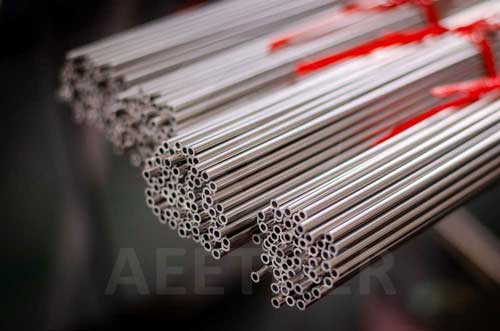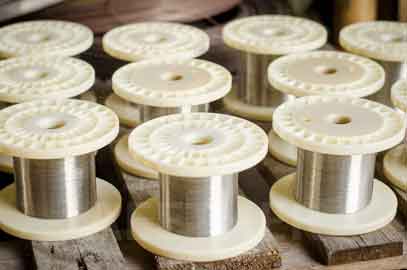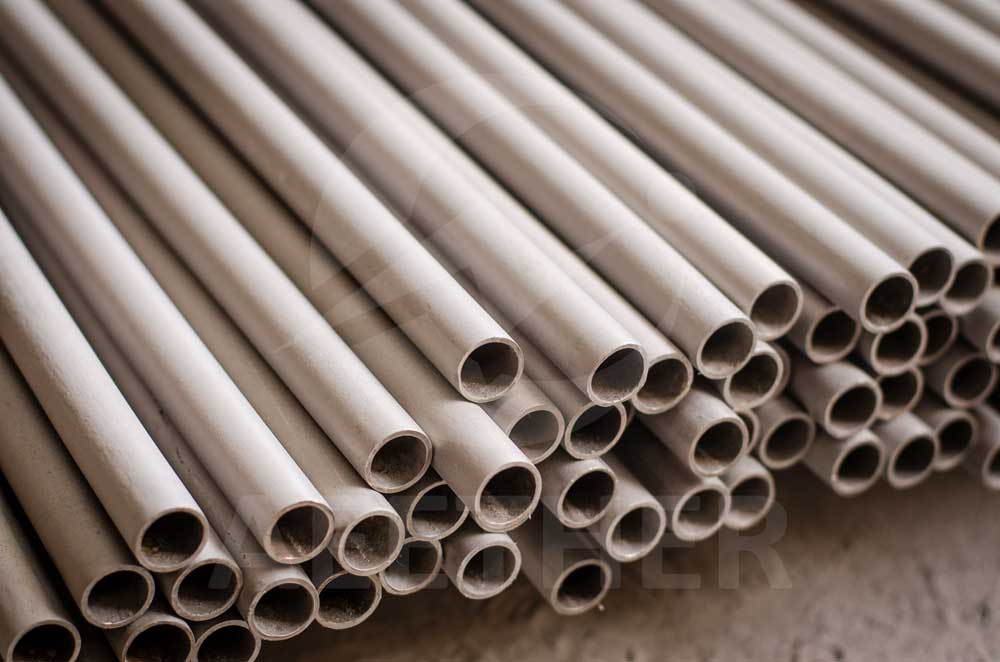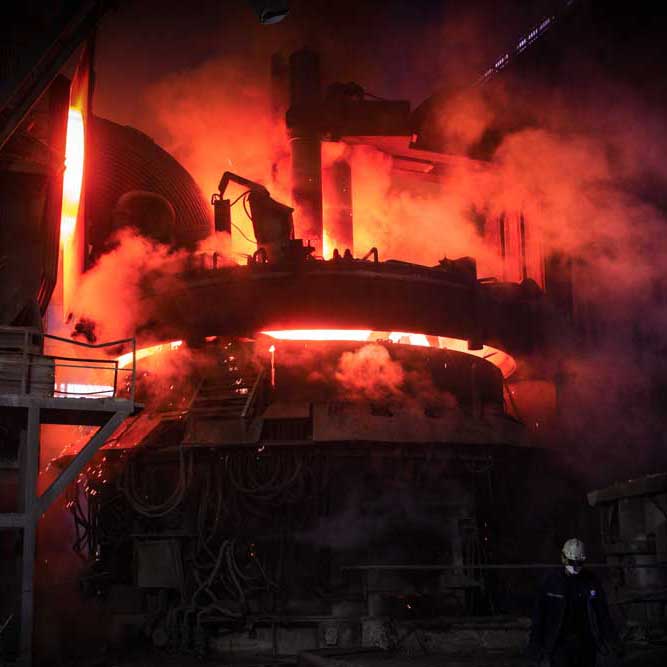Incoloy Alloy
DS
Incoloy DS Introduction

Solid Solution
Strengthened Alloy
Resistance
Behavior
Overview
As a leading supplier & manufacturer in China, AEETHER supply cost-effective Incoloy DS Products.
INCOLOY® alloy DS (W. Nr. 1.4862), first developed for woven wire furnace conveyor belts, is now widely used for a range of heat-treatment applications where its strength and corrosion resistance at high temperatures enable its use in light section.
Alloys for use in high-temperature processes must be able to withstand exposure to hot combustion gases and operating atmospheres for a considerable period of time without the loss of effective section that can be caused by corrosion.
INCOLOY alloy DS, in common with other Special Metals Corporation heat-resisting alloys, develops a tightly adherent oxide film that protects its surface against corrosion processes. It is also resistant to ‘green rot’ which can occur in nickel-chromium alloys when atmospheres vary between reducing and oxidizing, and in some cases where the reducing atmosphere is of a carburizing nature. In these conditions chromium carbide can form along the grain boundaries and preferential oxidation of the depleted chromium atrix follows, a form distinct from ordinary oxidation which produces a passive oxide film.
INCOLOY alloy DS is also resistant to ‘sigma’ phase, a hard, brittle, complex intermetallic compound, basically iron-chromium, which precipitates in the 600-900°C range from structures that are either ferritic, mixed ferrite and austenite, or marginally austenitic. Nickel, an austenite former, suppresses the tendency to ‘sigma’ phase formation and INCOLOY alloy DS, with a nominal 37% nickel content, may be heated indefinitely within the 600-900°C range without fear of ‘sigma’ phase embrittlement.
Thus, the corrosion resistance and strength of INCOLOY alloy DS account for its use in a wide variety of high temperature process equipment ranging from furnace retorts and heat treatment jigs to components used in domestic appliances.
Mechanical Properties
INCOLOY alloy DS has high mechanical strength over a broad temperature range. In general, alloy DS is used for its strength characteristics at service temperatures up to about 1500°F (816°C). At those temperatures, equipment design is usually based on tensile properties. For applications that require high creep or rupture strength, INCOLOY alloys DSH and DSHT are used.
Corrosion Resistance
INCOLOY alloy DS, like many austenitic stainless steels, can be sensitized, or made susceptible to intergranular attack in some aggressive media, by exposure to the temperature range of 1000 to 1400°F (540–760°C). The Huey test determines susceptibility to sensitization. The test involves exposure of a specimen to boiling 65% nitric acid for five consecutive 48-hour periods. An average corrosion rate for the five periods of substantially over about 24 mils penetration per year (0.61 mm/yr) indicates that the specimen is sensitized to some degree.
When INCOLOY alloy DS is exposed to heat from welding or other operations, care should be taken to avoid sensitization if the material is to be pickled or subjected to other aggressive environments. Sensitization is not a problem in most high-temperature applications.
Incoloy DS Chemical Composition
Try our Premium Products





















Incoloy DS Standards
Data Sheet
Physical Properties
| Density | g/cm3 | 7.86 | |
|---|---|---|---|
| lb/in.3 | 0.284 | ||
| Melting Range | °C | 1330 - 1400 | |
Mechanical Properties
| °C | 0.1% proof stress MPa |
0.2% proof stress MPa |
Tensile Strength MPa |
Elongationon 5.65 √ So % |
Reduction of Area % |
|---|---|---|---|---|---|
| sheet, cold-rolled, heat treated | |||||
| 20 | 327 | 363 | 687 | 37.1 | - |
| 100 | 310 | 329 | 629 | 36.3 | - |
| 200 | 284 | 303 | 616 | 32.7 | - |
| 300 | 292 | 304 | 607 | 36.7 | - |
| 400 | 286 | 297 | 602 | 35.2 | - |
| 500 | 269 | 283 | 578 | 35.4 | - |
| 600 | 239 | 253 | 482 | 40.1 | - |
| 700 | 195 | 208 | 335 | 48.8 | - |
| 800 | 107 | 116 | 181 | 75.7 | - |
| 900 | 63 | 66 | 105 | 79.9 | - |
| 1000 | 31 | 36 | 65 | 74.6 | - |
| plate, hot-rolled, heat treated 10 min/1020°C/AC | |||||
| -196 | 473 | 485 | 914 | 54.5 | 68.1 |
| 20 | 298 | 301 | 670 | 47.6 | 71.5 |
| 100 | 263 | 269 | 618 | 44.1 | 69.0 |
| 200 | 242 | 247 | 581 | 41.1 | 64.0 |
| 300 | 219 | 222 | 593 | 41.5 | 62.1 |
| 400 | 213 | 219 | 593 | 46.7 | 60.8 |
| 500 | 196 | 202 | 568 | 43.6 | 57.3 |
| 600 | 196 | 201 | 490 | 45.3 | 45.0 |
| 700 | 179 | 185 | 351 | 56.7 | 44.9 |
| 800 | 136 | 142 | 208 | 74.0 | 60.7 |
| 900 | 63 | 71 | 119 | 90.9 | 75.1 |
| 1000 | 37 | 42 | 73 | 111.3 | 82.2 |
| plate, hot-rolled, heat treated 1h/1150°C/AC | |||||
| -196 | 391 | 406 | 798 | 61.1 | 75.5 |
| 20 | 210 | 219 | 602 | 61.1 | 77.0 |
| 100 | 188 | 196 | 551 | 55.0 | 70.9 |
| 200 | 164 | 168 | 528 | 55.6 | 71.4 |
| 300 | 133 | 136 | 505 | 55.6 | 68.0 |
| 400 | 133 | 136 | 511 | 62.2 | 64.3 |
| 500 | 119 | 124 | 493 | 64.4 | 67.8 |
| 600 | 113 | 116 | 440 | 55.5 | 44.6 |
| 700 | 117 | 124 | 334 | 31.1 | 37.3 |
| 800 | 137 | 145 | 232 | 35.6 | 32.0 |
| 900 | 66 | 74 | 122 | 86.7 | 61.9 |
| 1000 | 37 | 42 | 73 | 97.8 | 66.3 |
| plate, hot-rolled, heat treated and welded | |||||
| -196 | 558 | 579 | 951 | 31.1 | 41.6 |
| 20 | 360 | 380 | 672 | 38.9 | 71.1 |
| 100 | 290 | 314 | 468 | 13.3 | 22.3 |
| 200 | 303 | 317 | 595 | 33.3 | 66.7 |
| 300 | 300 | 306 | 588 | 38.9 | 58.6 |
| 400 | 280 | 297 | 582 | 37.8 | 63.9 |
| 500 | 276 | 300 | 562 | 36.7 | 48.0 |
| 600 | 252 | 266 | 513 | 36.7 | 56.5 |
| 700 | 221 | 233 | 408 | 32.2 | 47.8 |
| 800 | 159 | 171 | 235 | 35.6 | 65.9 |
| 900 | 82 | 88 | 124 | 52.2 | 81.2 |
| 1000 | 46 | 48 | 76 | 42.2 | 88.7 |
Incoloy DS Applications
Related Article
More Incoloy Grades +
800
Si
C
Mn
Al
Ti
Cu
Fe
Cr
Ni
800H
Si
C
Mn
Al
Ti
Cu
Fe
Cr
Ni
800HT
Si
C
Mn
Al
Ti
Cu
Fe
Cr
Ni
803
Si
C
Mn
Al
Ti
Cu
Fe
Cr
Ni
825
Si
Mn
Al
Ti
Cu
Mo
Fe
Cr
Ni
832
Si
Ti
Cu
Fe
Cr
Ni
864
Si
C
Mn
Ti
Cu
Mo
Fe
Cr
Ni
890
Si
C
Mn
Ti
Cu
Nb
Mo
Fe
Cr
Ni
903
Al
Ti
Co
Nb
Fe
Ni
907
Si
Al
Ti
Co
Nb
Fe
Ni
908
Si
Mn
Al
Ti
Cu
Co
Nb
Fe
Cr
Ni
909
Si
Mn
Al
Ti
Cu
Co
Nb
Fe
Cr
Ni
925
Si
Mn
Al
Ti
Cu
Nb
Mo
Fe
Cr
Ni
926
Si
Mn
N
Cu
Mo
Fe
Cr
Ni
945
Si
Mn
Al
Ti
Cu
Nb
Mo
Fe
Cr
Ni
945X
Si
Mn
Al
Ti
Cu
Nb
Mo
Fe
Cr
Ni
MA956
C
Al
Ti
Fe
Cr
A-286
Si
C
Mn
Al
Ti
V
Mo
Fe
Cr
Ni
020
Si
C
Mn
Cu
Mo
Fe
Cr
Ni
028
Si
Mn
Cu
Mo
Fe
Cr
Ni
DS
Si
C
Mn
Cu
Co
Fe
Cr
Ni
330
Si
C
Mn
Cu
Fe
Cr
Ni
25-6HN
Si
Mn
N
Cu
Mo
Fe
Cr
Ni
27-7MO
Si
Mn
N
Cu
Mo
Fe
Cr
Ni





























